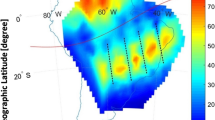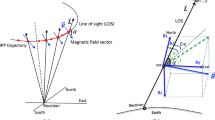Abstract
Small-scale irregularities in the background electron density of the ionosphere can cause rapid fluctuations in the amplitude and phase of radio signals passing through it. These rapid fluctuations are known as scintillation and can cause a Global Positioning System (GPS) receiver to lose lock on a signal. This could compromise the integrity of a safety of life system based on GPS, operating in auroral regions. In this paper, the relationship between the loss of lock on GPS signals and ionospheric scintillation in auroral regions is explored. The period from 8 to 14 November 2004 is selected for this study, as it includes both geomagnetically quiet and disturbed conditions. Phase and amplitude scintillation are measured by GPS receivers located at three sites in Northern Scandinavia, and correlated with losses of signal lock in receivers at varying distances from the scintillation receivers. Local multi-path effects are screened out by rejection of low-elevation data from the analysis. The results indicate that losses of lock are more closely related to rapid fluctuations in the phase rather than the amplitude of the received signal. This supports the idea, suggested by Humphreys et al. (2005) (performance of GPS carrier tracking loops during ionospheric scintillations. Proceedings Internationsl Ionospheric Effects Symposium 3–5 May 2005), that a wide loop bandwidth may be preferred for receivers operating at auroral latitudes. Evidence from the Imaging Riometer for Ionospheric Studies (IRIS) appears to suggest that, for this particular storm, precipitation of particles in the D/E regions may be the mechanism that drives the rapid phase fluctuations in the signal.






Similar content being viewed by others
References
Beach TL, Kintner PM (2001) Development and use of a GPS ionospheric scintillation monitor. IEEE Trans Geosci Remote Sens 39(5): 918–928
Blewitt G (1990) An automatic editing algorithm for GPS data. Geophys Res Lett 17(3):199–202
Conker RS, Bakry El-Arini M, Christopher J. Hegarty, Hsiao T (2003) Modelling the effects of ionospheric scintillation on GPS/satellite-based augmentation system availability. Radio Sci 38(1):1001, doi:10.1029/2000RS002604
Crane, Robert K (1977) Ionospheric scintillation. Proceedings of the IEEE 65(2): 180–199
Doherty PH, Delay SH, Valladares CE, Klobuchar JA (2000) Ionospheric scintillation effects in the equatorial and auroral regions. In: Proceedings ION GPS, 19–22 September 2000, Salt Lake City
Forte B(2005) Optimum detrending of raw GPS data for scintillation measurements at auroral latitudes. J Atmos Solar-Terrestrial Phys 67(12):1100–1109
Gau Y, Li Z (1999) Cycle-slip detection and ambiguity resolution algorithms for dual frequency GPS data processing. Mar Geod 22(4):169–181
Humphreys TE, Psiaki ML, Ledvina BM, Kintner PM (2005) Performance of GPS carrier tracking loops during ionospheric scintillations. Proceedings International Ionospheric Effects Symposium 3–5 May 2005, Alexandria
Kaplan ED (ed) (1996) Understanding GPS: principles and applications, 1st edn. Artech House, Boston, pp 247–251, ISBN 0890067937
Ledvina BM, Kintner PM, Makela JJ (2004) Temporal properties of intense GPS L1 amplitude scintillations at midlatitudes. Radio Science 39, RS1S18, doi:10.1029/2002RS002832
Materassi M, Mitchell CN (2006) Wavelet analysis of GPS amplitude scintillation, a case study. Radio Science (in press)
Mitchell CN, Spencer PSJ (2003) A three-dimensional time-dependent algorithm for ionospheric imaging using GPS. Ann Geophys 46(4):687–696
Mitchell CN, Alfonsi L, De Francesci G, Lester M, Romano V (2005) GPS TEC and scintillation measurements from the polar ionosphere during the October 2003 storm. Geophys Res Lett 32, L12S03, doi:10.1029/2004GL021644
Morrissey TN, Shallberg KW, Van Dierendonck AJ, Nicholson MJ (2004) GPS receiver performance characterization under realistic ionospheric phase scintillation environments. Radio Sci 39 RS1S20, doi:10.1029/2002RS002838, 2004
Skone S, Knudsen K, de Jong M (2001) Limitations in GPS receiver tracking performance under ionospheric scintillation conditions. Phys Chem Earth (A) 26(6–8):613–621
Van Dierendonck AJ, Hua Q, Fenton P, John K (1996) Commercial ionospheric scintillation monitoring receiver development and test results. In: Proceedings annual technical meeting of the Institute of Navigation pp 573–582
Yeh KC, Liu CH (1982) Radio wave scintillations in the ionosphere. Proceedings of the IEEE 70(4): 324–360
Acknowledgments
This work is funded by the UK Engineering and Physical Sciences Research Council (EPSRC). We are grateful to the International GNSS Service (IGS) for the use of GPS data. We also wish to thank the EISCAT Scientific Association for their support. EISCAT is an International Association supported by Finland (SA), France (CNRS), Germany (MPG), Japan (NIPR), Norway (NFR), Sweden (NFR) and the United Kingdom (PPARC). The riometer data originated from the Imaging Riometer for Ionospheric Studies (IRIS), operated by the Department of Communications Systems at Lancaster University (UK) in collaboration with the Sodankylä Geophysical Observatory, and funded by the Particle Physics and Astronomy Research Council (PPARC).
Author information
Authors and Affiliations
Corresponding author
Rights and permissions
About this article
Cite this article
Meggs, R.W., Mitchell, C.N. & Honary, F. GPS scintillation over the European Arctic during the November 2004 storms. GPS Solut 12, 281–287 (2008). https://doi.org/10.1007/s10291-008-0090-3
Received:
Accepted:
Published:
Issue Date:
DOI: https://doi.org/10.1007/s10291-008-0090-3




